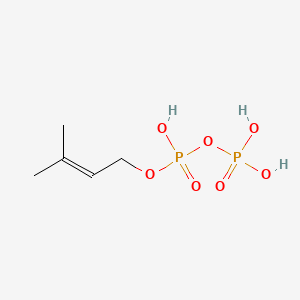| MeSH term | MeSH ID | Detail |
|---|---|---|
| Melanoma | D008545 | 69 associated lipids |
Dimethylallyl pyrophosphate
Dimethylallyl pyrophosphate is a lipid of Prenol Lipids (PR) class. Dimethylallyl pyrophosphate is associated with abnormalities such as Consumption-archaic term for TB and Wiskott-Aldrich Syndrome. The involved functions are known as Anabolism, Biochemical Pathway, Oxidation, Process and Chelating Activity [MoA]. Dimethylallyl pyrophosphate often locates in Chloroplasts, Plastids, chloroplast stroma, Cytosol and Cell membrane. The associated genes with Dimethylallyl pyrophosphate are IRF6 wt Allele and ADRBK1 gene. The related lipids are Sterols.
Cross Reference
Introduction
To understand associated biological information of Dimethylallyl pyrophosphate, we collected biological information of abnormalities, associated pathways, cellular/molecular locations, biological functions, related genes/proteins, lipids and common seen animal/experimental models with organized paragraphs from literatures.
What diseases are associated with Dimethylallyl pyrophosphate?
Dimethylallyl pyrophosphate is suspected in and other diseases in descending order of the highest number of associated sentences.
Related references are mostly published in these journals:
| Disease | Cross reference | Weighted score | Related literature |
|---|
Possible diseases from mapped MeSH terms on references
We collected disease MeSH terms mapped to the references associated with Dimethylallyl pyrophosphate
PubChem Associated disorders and diseases
What pathways are associated with Dimethylallyl pyrophosphate
Lipid pathways are not clear in current pathway databases. We organized associated pathways with Dimethylallyl pyrophosphate through full-text articles, including metabolic pathways or pathways of biological mechanisms.
Related references are published most in these journals:
| Pathway name | Related literatures |
|---|
PubChem Biomolecular Interactions and Pathways
Link to PubChem Biomolecular Interactions and PathwaysWhat cellular locations are associated with Dimethylallyl pyrophosphate?
Visualization in cellular structure
Associated locations are in red color. Not associated locations are in black.
Related references are published most in these journals:
| Location | Cross reference | Weighted score | Related literatures |
|---|
What functions are associated with Dimethylallyl pyrophosphate?
Related references are published most in these journals:
| Function | Cross reference | Weighted score | Related literatures |
|---|
What lipids are associated with Dimethylallyl pyrophosphate?
Related references are published most in these journals:
| Lipid concept | Cross reference | Weighted score | Related literatures |
|---|
What genes are associated with Dimethylallyl pyrophosphate?
Related references are published most in these journals:
| Gene | Cross reference | Weighted score | Related literatures |
|---|
What common seen animal models are associated with Dimethylallyl pyrophosphate?
There are no associated biomedical information in the current reference collection.
NCBI Entrez Crosslinks
All references with Dimethylallyl pyrophosphate
Download all related citations| Authors | Title | Published | Journal | PubMed Link |
|---|---|---|---|---|
| Yang J et al. | Enhancing production of bio-isoprene using hybrid MVA pathway and isoprene synthase in E. coli. | 2012 | PLoS ONE | pmid:22558074 |
| Xu W et al. | A closer look at the spectroscopic properties of possible reaction intermediates in wild-type and mutant (E)-4-hydroxy-3-methylbut-2-enyl diphosphate reductase. | 2012 | Biochemistry | pmid:22646150 |
| Wollinsky B et al. | Prenylation at the indole ring leads to a significant increase of cytotoxicity of tryptophan-containing cyclic dipeptides. | 2012 | Bioorg. Med. Chem. Lett. | pmid:22617493 |
| Diaz ME et al. | Characterization of an isopentenyl diphosphate isomerase involved in the juvenile hormone pathway in Aedes aegypti. | 2012 | Insect Biochem. Mol. Biol. | pmid:22782071 |
| Gonzales-Vigil E et al. | Evolution of TPS20-related terpene synthases influences chemical diversity in the glandular trichomes of the wild tomato relative Solanum habrochaites. | 2012 | Plant J. | pmid:22563774 |
| Wu S et al. | Engineering triterpene metabolism in tobacco. | 2012 | Planta | pmid:22729821 |
| Türsen U | Pathophysiology of the Behçet's Disease. | 2012 | Patholog Res Int | pmid:21977335 |
| Lamsen EN and Atsumi S | Recent progress in synthetic biology for microbial production of C3-C10 alcohols. | 2012 | Front Microbiol | pmid:22701113 |
| Fatima T et al. | Fatty acid composition of developing sea buckthorn (Hippophae rhamnoides L.) berry and the transcriptome of the mature seed. | 2012 | PLoS ONE | pmid:22558083 |
| Tidten-Luksch N et al. | IspE inhibitors identified by a combination of in silico and in vitro high-throughput screening. | 2012 | PLoS ONE | pmid:22563402 |
| Luo H et al. | Analysis of the transcriptome of Panax notoginseng root uncovers putative triterpene saponin-biosynthetic genes and genetic markers. | 2011 | BMC Genomics | pmid:22369100 |
| Heaps NA and Poulter CD | Synthesis and evaluation of chlorinated substrate analogues for farnesyl diphosphate synthase. | 2011 | J. Org. Chem. | pmid:21344952 |
| Emma F et al. | Renal mitochondrial cytopathies. | 2011 | Int J Nephrol | pmid:21811680 |
| Sivy TL et al. | Evidence of isoprenoid precursor toxicity in Bacillus subtilis. | 2011 | Biosci. Biotechnol. Biochem. | pmid:22146731 |
| Bleeker PM et al. | RNA-seq discovery, functional characterization, and comparison of sesquiterpene synthases from Solanum lycopersicum and Solanum habrochaites trichomes. | 2011 | Plant Mol. Biol. | pmid:21818683 |
| Battilana J et al. | Functional effect of grapevine 1-deoxy-D-xylulose 5-phosphate synthase substitution K284N on Muscat flavour formation. | 2011 | J. Exp. Bot. | pmid:21868399 |
| Zeng Y et al. | A proteomic analysis of the chromoplasts isolated from sweet orange fruits [Citrus sinensis (L.) Osbeck]. | 2011 | J. Exp. Bot. | pmid:21841170 |
| Muraguchi T et al. | Polished rice as natural sources of cancer-preventing geranylgeranoic acid. | 2011 | J Clin Biochem Nutr | pmid:21765600 |
| Okada K | The biosynthesis of isoprenoids and the mechanisms regulating it in plants. | 2011 | Biosci. Biotechnol. Biochem. | pmid:21737944 |
| Jang HJ et al. | Retinoid production using metabolically engineered Escherichia coli with a two-phase culture system. | 2011 | Microb. Cell Fact. | pmid:21801353 |
